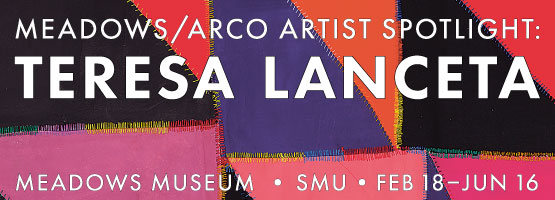If fashion has a place in a museum, is it just brand promotion, or is it as vital as any other of the decorative arts and architecture? The debate pops up any time a museum mounts such a show. Yet in Dallas-Fort Worth and across the country, fashion exhibitions have proven to be popular. Between 2018 and 2019, two fashion exhibitions visited the region. An estimated 33,000 people saw Balenciaga in Black at the Kimbell Art Museum, an exhibition of the Spanish designer Cristóbal Balenciaga. Months later, the Dallas Museum of Art hosted the blockbuster travelling exhibition Dior: From Paris to the World about the designer Christian Dior.
“In terms of the history of painting and art, you get more images of everyday life reflecting the emerging middle class. We’re also asking, what is fashion?” said Amanda Dotseth, curator at the Meadows and co-curator of the exhibition with Elvira González of the Museo del Traje. The exhibit draws primarily from the Meadows’s permanent collection. “I wanted to do something to inform the permanent collection,” Dotseth said. “We sat down and went through key works in the collection and looked at direct correlations.”
For González, the Museo del Traje curator, “by pairing the Museo del Traje’s collection with that of the Meadows, we are bringing the dress, accessories, and other material objects to life, enabling viewers to see the contexts in which such articles were worn.”
Those include Antonio Casanova y Estorach’s 1887 oil on canvas Favorites of the Court portraying decked-out Spanish men and women. It appears alongside a French-inspired slender brown silk, linen and cotton suit seen on one of the men. Others include Ignacio Zuloaga y Zabaleta’s The Bullfighter “El Segovianito” oil on canvas from 1912 depicting an attractive man wearing an ornate silk and cotton green and blue traje de luces, or bullfighter’s outfit. A similar outfit accompanies it. Zuloaga’s 1918 oil on canvas Portrait of the Duchess of Arión, Marchioness of Bay is displayed alongside a mantón de Manila, or a silk shawl from Manila (then a Spanish colony). Abutting Joan Miró’s abstract 1929 oil on canvas Queen Louise of Prussia is an airy, short painted blue and yellow dress with red stripes and shoes by fashion designer Manuel Piña in 1991. Piña’s outfit is the last in the show and, of note, the only one where the designer is known.
But ritzy fashion worn exclusively by the elite and wealthy do not make up the bulk of the exhibition. That’s because of the emergence of a middle class and a broader consumer culture beginning in the 18th century. With more money at their disposal, “a consumer culture developed, and people could own more than one outfit. The ideas of seasonal changes and fashion trends emerged and became popularized. There were emerging economic situations and trends as a result of colonialism and expansion of empires. The direct access to global trade, including Spain’s colonization of the Philippines, brought in techniques from the colonies,” she said. Shawls, for instance, began as Chinese garments. They were imported through Manila, thus earning the name Manila shawls.
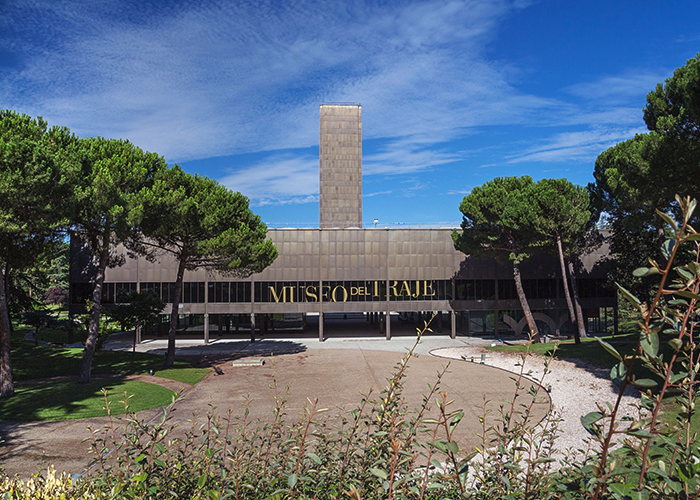
1 ⁄7
Façade of the Museo del Traje, Centro de Investigación del Patrimonio Etnológico, Madrid, Spain. Museo del Traje, Madrid. ©Museo del Traje Centro de Investigación del Patrimonio Etnológico, Madrid, Spain. Photo by Javier Maza.

2 ⁄7
LEFT: Traje de luces (chaquetilla, chaleco, calzón) [Bullfighter's Costume], 1876–1900. Silk, linen, cotton and silver metal. ©Museo del Traje Centro de Investigación del Patrimonio Etnológico, Madrid, Spain. Photo by Jesús Madriñán.
RIGHT: Ignacio Zuloaga y Zabaleta (Spanish, 1870–1945), The Bullfighter "El Segovianito," 1912. Oil on canvas. Meadows Museum, SMU, Dallas. Algur H. Meadows Collection. Photo by Kevin Todora.
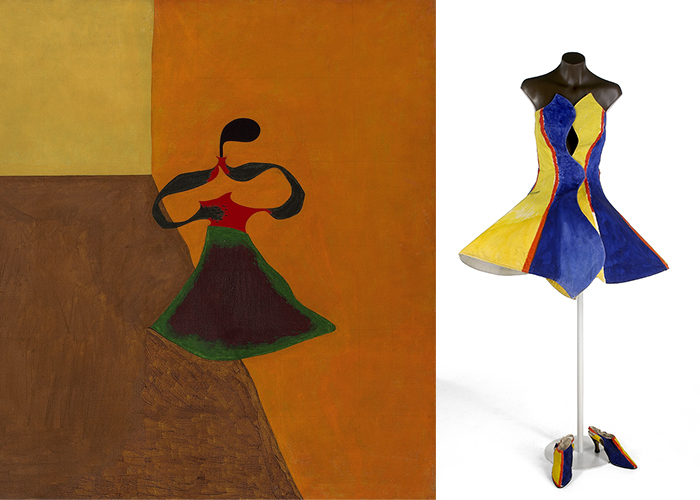
3 ⁄7
LEFT: Joan Miró (Spanish, 1893–1983), Queen Louise of Prussia, 1929. Oil on canvas. Meadows Museum, SMU, Dallas. Algur H. Meadows Collection, © Successió Miró / Artists Rights Society (ARS), New York / ADAGP, Paris, 2021. Photo by Michael Bodycomb.
RIGHT: Manuel Piña (Spanish, 1944–1994) [designer], Alex Serna [painter]; Vestido (Dress), 1991. Cellulose and cotton. Museo del Traje, Madrid. ©Museo del Traje. Centro de Investigación del Patrimonio Etnológico, Madrid, Spain. Photo by Lucía Ybarra Zubiaga.
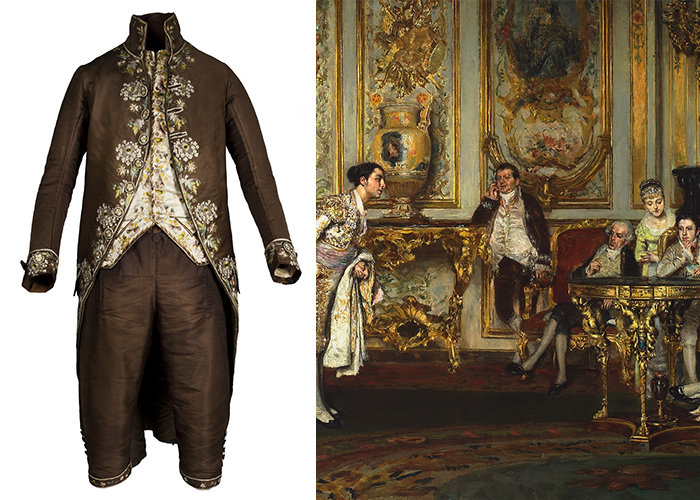
4 ⁄7
LEFT: Traje a “la francesca” (calzón, chupa, casaca) [French Costume (Breeches, Vest, Dress Coat)], c. 1795–1800. Silk, linen, and cotton. Museo del Traje, Madrid. ©Museo del Traje. Centro de Investigación del Patrimonio Etnológico, Madrid, Spain. Photo by Gonzalo Cases Ortega.
RIGHT: Antonio Casanova y Estorach (Spanish, 1847–1896), Favorites of the Court (detail), 1877. Oil on canvas. Meadows Museum, SMU, Dallas. Algur H. Meadows Collection. Photo by Michael Bodycomb.
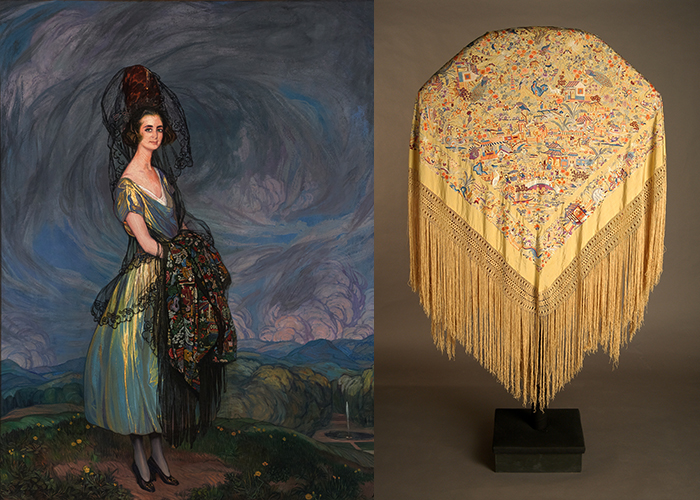
5 ⁄7
LEFT: Ignacio Zuloaga y Zabaleta (Spanish, 1870–1945), Portrait of the Duchess of Arión, Marchioness of Bay, 1918. Oil on canvas. Meadows Museum, SMU, Dallas. Museum purchase with funds generously provided by Mr. and Mrs. Walter Levy and Mr. and Mrs. Lawrence Hermele. Photo by Kevin Todora.
RIGHT: Mantón de Manila (embroidered Manila silk shawl), c. 1920. Silk. Museo del Traje, Madrid. ©Museo del Traje. Centro de Investigación del Patrimonio Etnológico, Madrid, Spain. Photo by Lucía Ybarra Zubiaga.
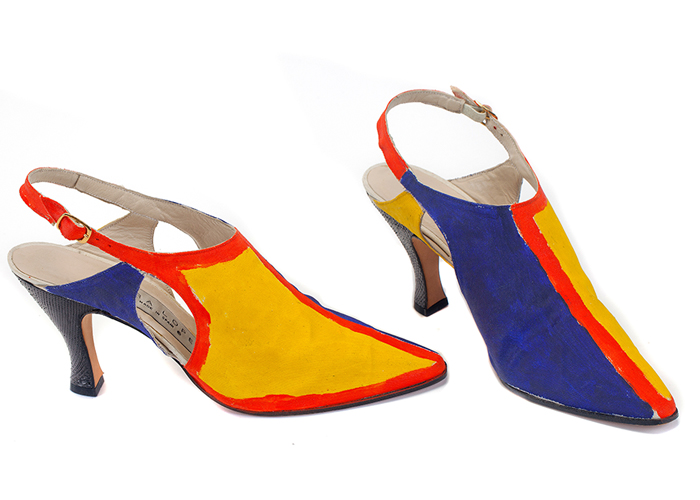
6 ⁄7
Manuel Piña (Spanish, 1944–1994) [designer], Alex Serna [painter]; Zapatos (Shoes), 1991. Leather and paint. Museo del Traje, Madrid. ©Museo del Traje. Centro de Investigación del Patrimonio Etnológico, Madrid, Spain; CE092707. Photo by David Serrano Pascual.

7 ⁄7
Traje a “la francesa” (French Costume), casaca and chupa (Vest and Dress Coat) [detail], c. 1795–1800. Silk, linen, and cotton. Museo del Traje, Madrid. ©Museo del Traje. Centro de Investigación del Patrimonio Etnológico, Madrid, Spain. Chupa, CE000664; casaca, CE000665. Photo by Munio Rodil Ares.
For men, tight stockings and trousers were the garb of the time and outfits showing off strong calves make up the silhouette. Showing off strong calves was a sign of strength and manliness. Yet, amusingly, that manliness was reinforced with form fitting suits, and heeled shoes. Eventually the emphasis on the calves wears off, the suits become loose and heeled shoes become a staple of women’s clothing.
Bringing context to the paintings is one of the curators’ goals, González said, and may inform how future curators present fashion in their museums. “Not only will our collection be seen by audiences in the U.S. for the first time, but it will also be displayed in a completely new light. We’re excited to see what kind of scholarship and new ideas might be generated by presenting these works in a new environment and alongside these paintings and drawings.”
—JAMES RUSSELL



